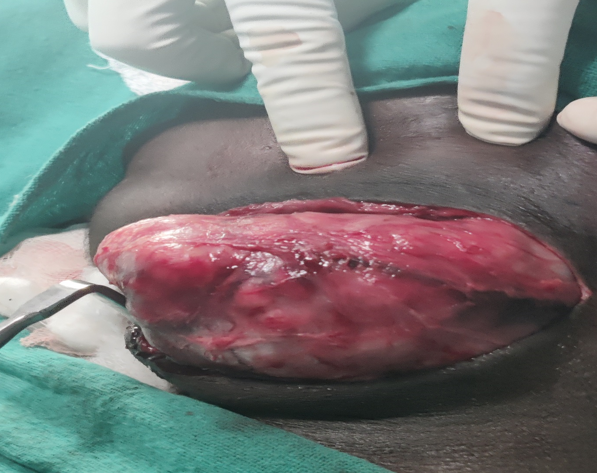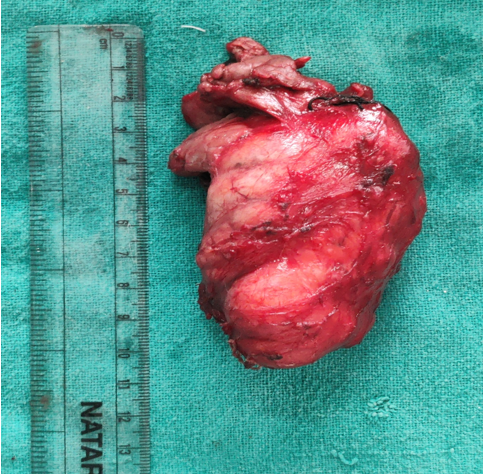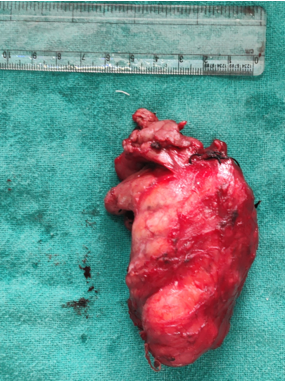Introduction
Pleomorphic adenoma is most common benign tumour involving the salivary glands.1 It is most commonly seen in parotid gland in 80% of cases. Submandibular gland accounts for about 10 % of cases and rest are found in minor salivary glands.2 In the present times due to more patient awareness about diseases and desire to look good it is hard to find huge masses in the head neck region. These tumours are slow growing but if not treated can grow into giant sizes.3
We report here a case of giant pleomorphic adenoma of sub mandibular gland in a twenty-year old male patient.
Case Report
A twenty-year old male patient presented to otolaryngology out patient wing with complaints of huge swelling on the left upper neck region for last seven years. He first noticed the mass at age of about 12 years and it gradually increased in size. As the parents of the patient were less educated he could not avail medical opinion for his condition. This giant tumour was causing facial disfigurement to the patient and was responsible for low self-esteem in him.
On examination a huge swelling was present over left submandibular region, it was firm in consistency, mobile and overlying skin was normal. Ultrasound revealed mixed echogenic tumour of left submandibular gland. Fine needle aspiration cytology findings were consistent with pleomorphic adenoma. The patient was advised left submandibular gland excision for which he gave consent readily.
The patient underwent submandibular gland excision on left side under general anaesthesia (Figure 1). Tumour was removed completely without any complications. The excised mass was about 12 x 8 cm (Figure 2, Figure 3). The procedure was uneventful and patient was discharged on seventh post op day.
Discussion
Up to 3% of head and neck malignancies are rare salivary gland tumours.4 Subhashraj investigated 422 benign cases of benign salivary gland tumours in a recent Asian study as part of a single institutional examination. 363 of these tumours (or 86% of them) were pleomorphic adenoma (PA). Among these 363 PA instances, 203 (56%) implicated the parotid, 72 (20%) the submandibular, and 1 (0.2%) the sublingual gland. The small salivary glands were the source of the remainder.5
The most frequent benign salivary gland tumour, called a pleomorphic adenoma, is most frequently detected in the parotid gland, with a 10% chance that it will also develop in the submandibular gland.6 Pleomorphic adenomas in the submandibular gland have been described by Belli et al and Schultz et al.7, 8
These tumours are smooth, painless and do not show any symptoms. The tumours with enormous size can generate pressure symptoms . The tumour is typically well separated from the surrounding tissue by a pseudocapsule. Little protrusions (pseudopodia) on the tumour may contribute to recurrence. They may take on a heterogenous appearance as they grow to huge dimensions from areas of haemorrhage, necrosis, cysts, and calcification.9
Histomorphologically, it has a variegated architecture made up of epithelial parts mixed in with a mucoid, myxoid, fibrohyaline, or chondroid stoma.10 The best radiological equipment is a CT scan or an MRI.11 It is crucial to assess the tumor's position in respect to the nearby structures before surgery.
While performing surgery, it is also vital to protect the nearby structures. Given their physical position, salivary gland tumours that develop in the submandibular gland as opposed to the parotid gland may have a higher likelihood of negatively affecting the nearby tissues, such as the trachea or cervical blood arteries, as they enlarge. It is essential to preserve the surrounding structure as well as excise the tumour in toto to prevent the recurrence.
Conclusion
Giant Pleomorphic adenomas are rare to find in submandibular glands. These tumours can grow to enormous sizes and cause compressive symptoms. The tumour also disfigures the facial appearance of the patient which can lead to low self-esteem in these patients. Early diagnosis and complete removal of the submandibular gland is the cure of this disorder.




